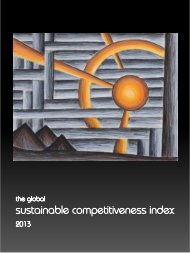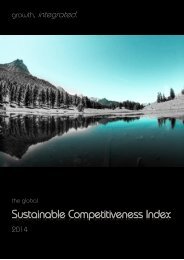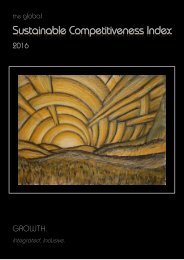The-Global-Sustainable-Competitiveness-Index-2015
Create successful ePaper yourself
Turn your PDF publications into a flip-book with our unique Google optimized e-Paper software.
Summary<br />
<strong>Sustainable</strong><br />
Competitive<br />
Natural<br />
Capital<br />
Social<br />
Capital<br />
Intellectual<br />
Capital<br />
Resource<br />
Management<br />
Governance Spotlight Data<br />
4 Resource Management<br />
<strong>The</strong> second level of the sustainable competitiveness pyramid is the ability to<br />
manage available resource (natural capital, human capital, financial capital)<br />
efficiently – regardless of whether the capital is scarce or abundant. Whether a<br />
country does or does not possess resources within its boundaries (natural and<br />
other resources), efficiency in using resources – whether domestic or imported -<br />
is a cost factor, affecting the competitiveness and thus wealth of nations. Overexploitation<br />
of existing natural resources also affects the natural capital of the<br />
country, i.e. the ability of a country to support its population and economy with<br />
the required resources into the future.<br />
In addition, non-renewable resources that are used today might be scarce and<br />
expensive tomorrow, affecting competitiveness, wealth and the quality of life in<br />
the future. A number of factors are pointing to rising cost for resources in the<br />
future, in particular natural resources: scarcity and depletion of energy, water,<br />
and mineral resources, increasing consumption (particular in non-OECD<br />
countries), financial speculation on raw materials, and possibly geo-political<br />
influences. <strong>The</strong> key objective of the resource management category is therefore<br />
to evaluate a country’s ability to deal with rising cost and sustain economic<br />
growth in the face of rising prices in the global commodity markets.<br />
Vital natural resources include water, energy, and raw materials. Most of the<br />
resources used today are non-renewable, or only partly renewable: fossil-based<br />
energy, and minerals. Water aquifers and other natural products (e.g. wood) are<br />
renewable, as long as their capacity is not overused and the replacement<br />
patterns are not drastically altered, e.g. trough depletion, biodiversity loss,<br />
pollution, or climate change.<br />
Key elements of competitiveness<br />
drivers in the Resource<br />
Management Sub-<strong>Index</strong><br />
Resource efficiency indicators are evaluated both in terms of intensity (per<br />
capita) and efficiency (relative GDP). <strong>The</strong> availability of accurate global data is<br />
not as wide as in other criteria, particularly in terms of usage of raw materials.<br />
Other than steel & minerals usage, reliable raw material usage statistics are not<br />
available on a global level. <strong>The</strong> focus is therefore on energy, energy sources,<br />
water, steel usage, as well as GHG emission intensity and productivity. For the full<br />
list of indicators, refer to the methodology section.<br />
the sustainable competitiveness index <strong>2015</strong><br />
page 27








